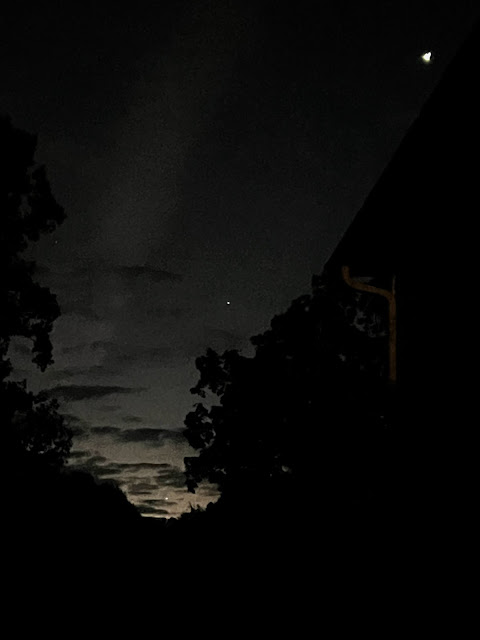Planets Galore, Fall And The Moon’s Shadow Are In Store
Hey, Space Placers!
Mercury (bottom), Regulus the star (middle) and Venus (top)Credit: Greg Redfern iPhone 13 Pro Max
Venus & Winter Constellations
Credit: Greg Redfern iPhone 13 Pro Max
If you are an early riser the pre-dawn sky is a delight to see. The stars of Winter - Orion the Hunter, Gemini the Twins and the brightest star in the night sky, Sirius - are all on full display right now. Add to that the brilliant planet Venus and elusive Mercury and you have a skywatcher’s dream.
Venus is unmistakeable in the Eastern sky around 4:30 a.m. local time and will climb higher in our skies in the weeks to come. Mercury becomes visible in the East in the brightening pre-dawn sky around 6:00 a.m. local time. It really helps to have a clear horizon and binoculars to help in locating Mercury. Mercury will brighten a bit and remain visible until the end of September.
Between higher Venus and lower Mercury is the bright star Regulus in Leo the Lion. They form a very nice diagonal line from Mercury to Venus.
Right after it gets dark, the planet Saturn is visible in the Southeast and the Moon will keep it company on the night of 26-27 September. Bright Jupiter joins the sky scene in the East around 11 p.m. local time with the Moon passing by the night of October 1st.
Fall https://earthsky.org/astronomy-essentials/everything-you-need-to-know-september-equinox/?mc_cid=2aecf48bb1&mc_eid=9aeb2a4318 - the Autumnal Equinox - will be upon us September 23rd, at 2:50 a.m. EST with the Sun rising due East that day https://earthsky.org/tonight/equinox-sun-rises-due-east-and-sets-due-west/?mc_cid=2aecf48bb1&mc_eid=9aeb2a4318 . The nights will become longer and the days shorter as the Sun moves along the horizon ever closer to Winter.
We have another and historic “fall” happening the very next day as NASA’s first ever asteroid sample return mission is due to re-enter our atmosphere and land in Utah.
NASA’s Goddard Visitor Center has “invited the public to a watch party at NASA’s Goddard Visitor Center, Greenbelt, Maryland to celebrate the first U.S. mission, OSIRIS-REx (Origins, Spectral Interpretation, Resource Identification and Security – Regolith Explorer) https://www.nasa.gov/osiris-rex , to collect a sample from an asteroid and deliver it to Earth on Sept. 24, 2023. NASA will broadcast and stream this milestone event live on NASA TV https://www.nasa.gov/multimedia/nasatv/index.html#public and social media starting at 10 a.m. EDT.” https://www.nasa.gov/press-release/goddard/2023/public-invited-to-nasa-s-goddard-visitor-center-to-celebrate-historic-asteroid-sample
NASA will unveil this sample from the Bennu Asteroid October 11, 2023, during a news conference at 11 a.m. EDT which will air live on NASA Television https://www.nasa.gov/multimedia/nasatv/index.html#public , the NASA app https://www.nasa.gov/connect/apps.html , and the agency’s website https://www.nasa.gov/live .During the event, NASA’s OSIRIS-REx science team will discuss an initial analysis of the sample.
Finally, as we watch the Moon travel across our sky it is headed for a rendezvous with the Sun on October 14th, 2023 https://eclipse.aas.org/ . The New Moon on that date will pass directly in front of the Sun giving skywatchers either a Partial or Annular eclipse https://www.farmersalmanac.com/ring-of-fire-solar-eclipse-2023-10-strange-facts?fbclid=IwAR01DN1WB_UkZZRlgMSe8tQYBQomdwPi9pVhC3aXimidZ2QKOR_X5zciR38 .
For the DMV we will see a Partial Solar Eclipse with about 30% of the Sun covered by the Moon.
To safely view this eclipse you have to use proper eye protection whenever looking at or photographing the Sun. You must follow the safety guidance provided by the American Astronomical Society (AAS) https://eclipse.aas.org/eye-safety . Don’t wait, order now safe and ISO compliant solar eclipse glasses https://eclipse.aas.org/resources/solar-filters .
I’ll be traveling to Texas to see both the Annular and Total Solar Eclipses.
I’ll have more on the Annular eclipse soon.
Sky Guy in VA




Comments
Post a Comment